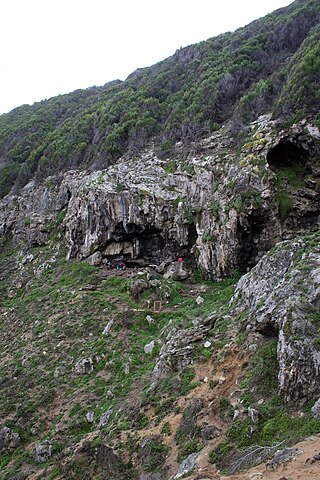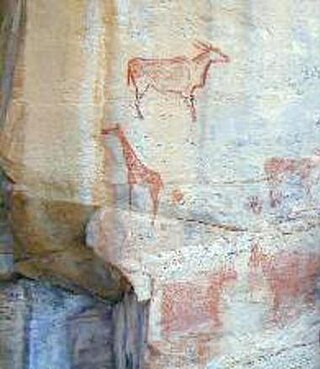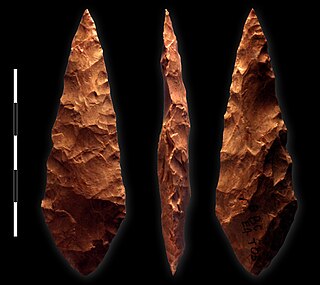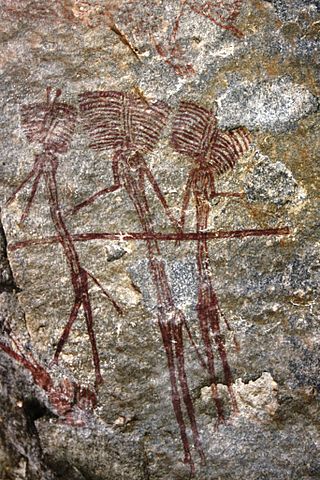Hoabinhian is a lithic techno-complex of archaeological sites associated with assemblages in Southeast Asia from late Pleistocene to Holocene, dated to c. 10,000–2000 BCE. It is attributed to hunter-gatherer societies of the region and their technological variability over time is poorly understood. In 2016 a rockshelter was identified in Yunnan (China), where artifacts belonging to the Hoabinhian technocomplex were recognized. These artifacts date from 41,500 BCE.

Blombos Cave is an archaeological site located in Blombos Private Nature Reserve, about 300 km east of Cape Town on the Southern Cape coastline, South Africa. The cave contains Middle Stone Age (MSA) deposits currently dated at between c. 100,000 and 70,000 years Before Present (BP), and a Late Stone Age sequence dated at between 2000 and 300 years BP. The cave site was first excavated in 1991 and field work has been conducted there on a regular basis since 1997, and is ongoing.

The Tsodilo Hills are a UNESCO World Heritage Site (WHS), consisting of rock art, rock shelters, depressions, and caves in southern Africa. It gained its WHS listing in 2001 because of its unique religious and spiritual significance to local peoples, as well as its unique record of human settlement over many millennia. UNESCO estimates there are over 4500 rock paintings at the site. The site consists of a few main hills known as the Child Hill, Female Hill, and Male Hill.

The Middle Stone Age was a period of African prehistory between the Early Stone Age and the Late Stone Age. It is generally considered to have begun around 280,000 years ago and ended around 50–25,000 years ago. The beginnings of particular MSA stone tools have their origins as far back as 550–500,000 years ago and as such some researchers consider this to be the beginnings of the MSA. The MSA is often mistakenly understood to be synonymous with the Middle Paleolithic of Europe, especially due to their roughly contemporaneous time span; however, the Middle Paleolithic of Europe represents an entirely different hominin population, Homo neanderthalensis, than the MSA of Africa, which did not have Neanderthal populations. Additionally, current archaeological research in Africa has yielded much evidence to suggest that modern human behavior and cognition was beginning to develop much earlier in Africa during the MSA than it was in Europe during the Middle Paleolithic. The MSA is associated with both anatomically modern humans as well as archaic Homo sapiens, sometimes referred to as Homo helmei. Early physical evidence comes from the Gademotta Formation in Ethiopia, the Kapthurin Formation in Kenya and Kathu Pan in South Africa.

The Kondoa Rock-Art Sites or Kondoa Irangi Rock Paintings are a series of ancient paintings on rockshelter walls in central Tanzania. The Kondoa region was declared a UNESCO World Heritage Site in 2006 because of its impressive collection of rock art. These sites were named national monuments in 1937 by the Tanzania Antiquities Department. The paintings are located approximately nine kilometres east of the main highway (T5) from Dodoma to Babati, about 20 km north of Kondoa town, in Kondoa District of Dodoma Region, Tanzania. The boundaries of the site are marked by concrete posts. The site is a registered National Historic Sites of Tanzania.

The Later Stone Age (LSA) is a period in African prehistory that follows the Middle Stone Age.
Enkapune Ya Muto, also known as Twilight Cave, is a site spanning the late Middle Stone Age to the Late Stone Age on the Mau Escarpment of Kenya. This time span has allowed for further study of the transition from the Middle Stone Age to the Late Stone Age. In particular, the changes in lithic and pottery industries can be tracked over these time periods as well as transitions from a hunter-gatherer lifestyle to a herding lifestyle. Beads made of perforated ostrich egg shells found at the site have been dated to 40,000 years ago. The beads found at the site represent the early human use of personal ornaments. Inferences pertaining to climate and environment changes during the pre-Holocene and Holocene period have been made based from faunal remains based in this site.
Howiesons Poort is a technological and cultural period characterized by material evidence with shared design features found in South Africa, Lesotho, and Namibia. It was named after the Howieson's Poort Shelter archaeological site near Grahamstown in South Africa, where the first assemblage of these tools was discovered. Howiesons Poort is believed, based on chronological comparisons between many sites, to have started around 64.8 thousand years ago and ended around 59.5 thousand years ago. It is considered to be a technocomplex, or a cultural period in archaeology classified by distinct and specific technological materials. Howiesons Poort is notable for its relatively complex tools, technological innovations, and cultural objects evidencing symbolic expression. One site in particular, Sibudu Cave, provides one of the key reference sequences for Howiesons Poort. Howiesons Poort assemblages are primarily found at sites south of the Limpopo River.

Border Cave is an archaeological site located in the western Lebombo Mountains in Kwazulu-Natal. The rock shelter has one of the longest archaeological records in southern Africa, which spans from the Middle Stone Age to the Iron Age.
The Apollo 11 Cave is an archeological site in the ǀAi-ǀAis/Richtersveld Transfrontier Park of south-western Namibia, approximately 250 km (160 mi) southwest of Keetmanshoop. The name given to the surrounding area and presumably the cave by the Nama people was "Goachanas". However, the cave was given its name by German archaeologist Wolfgang Erich Wendt (1934-2015) in reference to Apollo 11's then recent return to Earth.
Buur Heybe, which translates to "The Hill of the Potter's Sand", is a late Pleistocene and Holocene archaeological complex located in the largest granite inselberg in the inter-riverine region of the southern Bay province of Somalia approximately 180 km northwest of the capital Mogadishu. Buur Heybe has a longstanding history of archaeological research dating back to the 1930s when Paolo Graziosi carried out the first professional archaeological excavation in Somalia in the rockshelter site of Gogoshiis Qabe in Buur Heybe. Further excavations by J. Desmond Clark in the 1950s and later by the Buur Ecological and Archaeological Project (BEAP) led by Steven Brandt in the 1980s have made Buur Heybe one of the best dated and closely studied archaeological sites in Somalia.
Elands Bay Cave is located near the mouth of the Verlorenvlei estuary on the Atlantic coast of South Africa's Western Cape Province. The climate has continuously become drier since the habitation of hunter-gatherers in the Later Pleistocene. The archaeological remains recovered from previous excavations at Elands Bay Cave have been studied to help answer questions regarding the relationship of people and their landscape, the role of climate change that could have determined or influenced subsistence changes, and the impact of pastoralism and agriculture on hunter-gatherer communities.
Melkhoutboom Cave is an archaeological site dating to the Later Stone Age, located in the Zuurberg Mountains, Cape Folded Mountain Belt, in the Addo Elephant National Park, Sarah Baartman District Municipality in the Eastern Cape Province of South Africa.
Ngalue Cave is an archaeological site located in the Niassa province of Mozambique. Excavated primarily by Julio Mercader in 2007, Ngalue is a Middle Stone Age site. Due to its relatively dry environment and the shape of the cave, Ngalue had very good preservation and not only were stone tools and animal bones found. There were preserved starch grains on many of the stone tools as well. Overall, this site can help add to our knowledge of the Middle Stone Age site in the Niassa valley and to our understanding of the subsistence of Middle Stone Age peoples in Eastern Africa as a whole.
Porc-Epic Cave is an archaeological site located in Dire Dawa,Oromia, Ethiopia. Dated back to the Middle Stone Age, the site contains extensive evidence of microlithic tools, bone, and faunal remains. The lithic assemblage reveals that inhabitants at the time were well-organized with their environment. There is also rock art and strong evidence for ochre processing. The site was first discovered in 1920 by H. De Monfreid and P. Teilhard De Chardin. H. Breuil and P. Wernert performed the first excavation in 1933, followed from 1974 to 1976 by J. Desmond Clark and K.D. Williamson. Succeeding this was an excavation in 1998. Porc-Epic Cave provides insight into the behavior and technical capability of modern humans in eastern Africa during the Middle Stone Age.

Panga ya Saidi is an archaeological cave site located in Kilifi County, southeastern Kenya, about 15 km from the Indian Ocean in the Dzitsoni limestone hills. The cave site has rich archaeological deposits dating to the Middle Stone Age, Later Stone Age, and Iron Age. Excavated deposits preserve an unusually long record of human activities, from around 78,000 years ago until around 400 years ago, a chronology supported by radiocarbon dating and optically stimulated luminescence dating. This sequence puts Panga ya Saidi alongside other key sites such as Enkapune ya Muto, Mumba Rockshelter, and Nasera Rockshelter that are important for understanding the Late Pleistocene and the Middle to Later Stone Age transition in eastern Africa.
Nasera Rockshelter is an archaeological site located in the Ngorongoro Conservation Area within Ngorongoro District of Arusha Region in northern Tanzania, and it has evidence of Middle Stone Age and Later Stone Age occupations in the Late Pleistocene to early Holocene, and ceramic-bearing Holocene occupations attributed to Kansyore, Nderit, and Savanna Pastoral Neolithic traditions. It was first excavated by Louis Leakey in 1932. A second series of excavations by Michael Mehlman in 1975 and 1976 led to the first comprehensive published study of the shelter, its stratigraphy and chronology, and its abundant material culture, including stone tools, faunal remains, and pottery. Recent work has sought to better understand chronology, lithic technology, mobility and demography, and site formation processes at Nasera Rockshelter. Nasera Rockshelter is considered a key site in eastern Africa for understanding the Middle Stone Age to Later Stone Age transition, and also for the study of the spread of livestock herding during the Pastoral Neolithic. Its chronology and archaeological sequence have been compared to those of other key sites in the region such as Mumba Rockshelter, Kisese II Rockshelter, Panga ya Saidi, and Enkapune ya Muto.

The Mlambalasi Rock Shelter is a historic site located in Iringa District of Iringa Region in southern Tanzania, 50 km away from Iringa City. Excavations in 2006 and 2010 by the Iringa Region Archaeological Project uncovered artifactual deposits from the Later Stone Age (LSA), the Iron Age, and the historic periods, as well as external artifacts from the Middle Stone Age (MSA). Direct dating on Achatina shell and ostrich eggshell beads indicates that the oldest human burials at Mlambalasi are from the terminal Pleistocene. Mlambalasi is characterized by interment in the LSA and Iron Age periods, as well as by cycles of use and abandonment.

Mochena Borago is a rockshelter and archaeological site situated on the western slope of Mount Damota, nearest to the town of Wolaita Sodo in Ethiopia, located in the Southern Nations, Nationalities and Peoples Region. The site is well-dated, with 59 radiocarbon dates, which gives it one of the most secure chronologies among Late Pleistocene sites in the Horn of Africa and Eastern Africa. It is one of only a few African sites found with intact deposits dating to Marine Isotope Stage (MIS) 3 outside of South Africa, and was potentially a refugium for hunter-gatherering peoples during the cold and arid period of MIS 4. This makes it an important research site for testing the "refugium theory," which states that over the past 70,000 years, during cold, arid conditions, like those of the Last Glacial Maximum and MIS 4, humans sought refuge in the mountains of the southwest Ethiopian Highlands, which received higher rainfall, making them more habitable than the surrounding areas. Research at Mochena Borago is helping to reconstruct human behavior during the Late Pleistocene, and the paleoenvironment that Homosapiens would have inhabited at this time in the Horn of Africa.
Ostrich eggshell beads, considered among the earliest ornaments created by Homo sapiens, represent some of the most ancient fully manufactured beads. Archaeologists have traced their origins back to the Late Pleistocene, with evidence suggesting they were crafted as early as 75,000 years ago in Africa. Certain populations continue to produce and utilize these beads in contemporary times.











